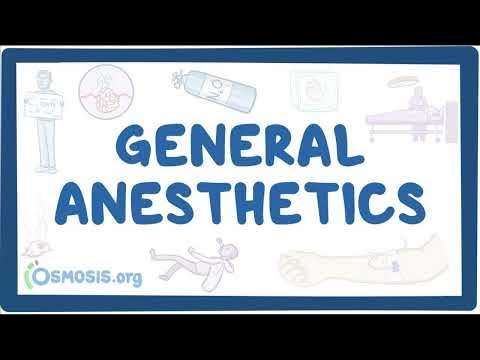Pharmacology - Local Anaesthetic
Summary
TLDRThis video offers an insightful overview of local anesthetics, their use in minor surgeries, and their mechanism of action on nerve fibers. It explains how local anesthetics, like lidocaine and bupivacaine, penetrate the cell membrane to block sodium channels, preventing pain signals from reaching the brain. The video also touches on the history of anesthetics, mentioning cocaine as the first discovered, and discusses side effects and the unique properties of tetrodotoxin from pufferfish. It concludes with a look at different types of local anesthetics, their applications, and potential risks.
Takeaways
- 😲 Local anesthetics are used to numb a small part of the body during minor surgery.
- 🌿 Cocaine was one of the first local anesthetics discovered and is still used today.
- 💊 The effectiveness of local anesthetics depends on their form; in an ionized form, they cannot penetrate the cell membrane.
- 🔬 Local anesthetics work by penetrating the cell membrane in an un-ionized form and then ionizing inside the neuron to block sodium channels, preventing nerve impulse propagation.
- 🚫 Local anesthetics are more effective on smaller nerve fibers and particularly on myelinated fibers.
- 🐡 Tetrodotoxin (TTX), a natural toxin secreted by pufferfish, also blocks sodium channels but from the outside, unlike common local anesthetics.
- 💡 Lidocaine, also known as 'League no pain', is a commonly used local anesthetic with rapid induction and medium duration, often used in dentistry.
- 🚨 Side effects of local anesthetics can include headache, dizziness, confusion, and potentially fatal CNS depression.
- 💔 Local anesthetics can also affect the heart, causing myocardial depression and vasodilation.
- 🛑 Bupivacaine is used for long surgeries due to its long duration but requires caution due to high cardio toxicity.
- 👍 The video provides a brief but informative overview of local anesthetics, their mechanisms, and their clinical applications.
Q & A
What are local anesthetics used for in medical procedures?
-Local anesthetics are used to numb a small part of the body during minor surgery, preventing the sensation of pain in the area where they are administered.
Who discovered cocaine as an anesthetic and what is its significance?
-Cocaine was one of the first anesthetics discovered and was the first ester-type local anesthetic. It has historical significance as a milestone in the development of local anesthetics.
How does the form of a drug affect its ability to be absorbed by the body?
-A drug in its unionized form can penetrate the cell membrane and be absorbed by the body, whereas a drug in its ionized, polar form cannot penetrate the cell membrane and is less effective.
What is the pKa of a typical local anesthetic and how does it relate to its effectiveness?
-A typical local anesthetic has a pKa of about 8 and 9. In its unionized form, it can penetrate the cell membrane and is quite effective. However, at physiological pH, which is slightly acidic, it becomes ionized and less able to penetrate the cell membrane.
How do local anesthetics work to numb an area?
-Local anesthetics work by penetrating the cell membrane of nerve cells, becoming ionized inside, and binding to sodium channels, thus preventing the influx of sodium ions and blocking the propagation of nerve impulses, which numbs the area.
Why are local anesthetics more effective on smaller nerve fibers?
-Local anesthetics are more effective on smaller nerve fibers because they are more susceptible to the blocking action of the anesthetic compared to larger fibers.
What is the difference between tetrodotoxin (TTX) from pufferfish and local anesthetics used in hospitals?
-Tetrodotoxin (TTX) blocks the sodium channel from the outside, preventing sodium ions from entering the neuron and stopping the action potential. In contrast, local anesthetics used in hospitals typically block the sodium channel from the inside of the neuron.
What are some common side effects of using local anesthetics?
-Side effects of using local anesthetics can include headache, dizziness, confusion, and CNS depression, which can be fatal if it leads to respiratory depression.
How does cocaine differ from other local anesthetics in terms of side effects on the heart?
-Unlike other local anesthetics, cocaine does not cause myocardial depression but instead increases heart activity, which can lead to different cardiovascular effects.
What are some popular types of local anesthetics mentioned in the script?
-Some popular types of local anesthetics mentioned are lidocaine (known as 'League no pain' in some regions), which is used for its rapid induction and medium duration, and bupivacaine, which has a slow onset, long duration, and medium tissue penetration but is associated with high cardio toxicity.
Why is care needed when using bupivacaine as a local anesthetic?
-Care must be taken when using bupivacaine because it has high cardio toxicity, making it necessary to monitor patients, especially those with heart conditions, to avoid complications.
Outlines

هذا القسم متوفر فقط للمشتركين. يرجى الترقية للوصول إلى هذه الميزة.
قم بالترقية الآنMindmap

هذا القسم متوفر فقط للمشتركين. يرجى الترقية للوصول إلى هذه الميزة.
قم بالترقية الآنKeywords

هذا القسم متوفر فقط للمشتركين. يرجى الترقية للوصول إلى هذه الميزة.
قم بالترقية الآنHighlights

هذا القسم متوفر فقط للمشتركين. يرجى الترقية للوصول إلى هذه الميزة.
قم بالترقية الآنTranscripts

هذا القسم متوفر فقط للمشتركين. يرجى الترقية للوصول إلى هذه الميزة.
قم بالترقية الآن5.0 / 5 (0 votes)






